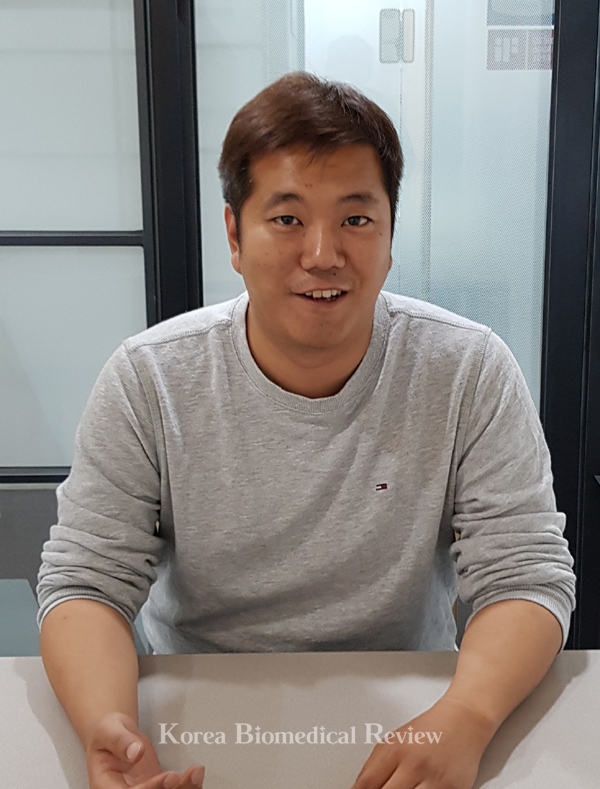Since IBM introduced Watson, an artificial intelligence-based medical device has become one of the hottest keywords in the biomedical sphere.
Lunit, abbreviated from “learning unit,” is a venture company devoted to developing such advanced medical image analytics and novel imaging biomarkers using AI and deep learning technology.

The company is focusing on radiology and plans to make doctors into "super doctors" by using their systems.
Most recently, the company has received regulatory approval from the Ministry of Food and Drug Safety for Lunit Insight CXR-Nodule, a web-based AI medical image diagnostic software, to help make accurate diagnostics for lung cancer. The platform is the second AI-based medical device approved in Korea.
Lunit Insight inputs and analyzes the chest X-ray (CXR) images of a patient and displays the degree of the suspected pulmonary nodule, which in turn helps doctors diagnose pulmonary nodule.
“Of the 100 patients with lung cancer, the probability of having lung cancer diagnosed by X-ray is 73.5 percent, compared to 93.8 percent diagnosis with computed tomography (CT),” Lunit Co-founder Park Sung-gyun said in an interview with Korea Biomedical Review.
Such ratio suggests that there is almost a 20 percent chance that a doctor may pass by a patients lung cancer symptoms, he added.
Lunit has dedicated itself to filling in the 20 percent gap by developing Lunit Insight and help make accurate diagnostics in the X-ray phase, Park said.
He noted that the company developed the platform to catch lung cancer symptoms early on so that patients can have a better chance of surviving the disease.
“The reason we decided to commercialize software for CXR is that lung cancer has a low survival rate as it is hard to find it in the early stages,” Park said. “Lung cancer is the leading cause of death among Koreans with a survival rate of only 6.1 percent if found in the late stages.”
Although the survival rate increases to 64 percent if detected early, the rate of early diagnosis of lung cancer patients in Korea is only 20.7 percent, he added.
In the past, the diagnosis of pulmonary nodules usually needed CT images. As CT images are expensive, however, most patients go through X-rays during their comprehensive medical checkup, which in turn lead to some lung cancers going unchecked.
“This is because chest X-rays can miss the lung cancer if the size of the lesion is small or covered by other organs, such as the heart, ribs, or pulmonary veins,” Park said. “Particularly, because of the nature of Korea’s medical field, the risk can be even higher in an environment where doctors read a large number of images in a short period.”
Asked how the company’s software compares with its competitors in the field, Park answered that Lunit Insight focuses on accuracy above all else.
“Although some firms emphasize efficiency as the most integral part of an AI solution, Lunit believes that accuracy is the key as medical solution deals with a patient’s life,” Park said. “The company has conducted various clinical trials have that proved AI can improve accuracy.”
Lunit has proved the accuracy of its platform through a clinical trial with Seoul National University Hospital.
The clinical trial showed that all physicians, including chest radiologists, had improved accuracy after using Lunit Insight. In clinical trials, the hospital assessed both image classification accuracy and lesion location accuracy. In particular, non-radiologists improved their accuracy by an average of 20 percent.
However, Park drew the line when asked if the software can make a diagnosis on its own without doctors.
“It is a software that helps the doctor to detect the abnormality of a suspected pulmonary nodule on chest X-ray,” Park said. “The physician first reads the chest X-ray image and then makes a final diagnosis by referring to the analysis results of Lunit Insight.”
Lunit Insight analysis alone cannot be used to determine the diagnosis and treatment plan of the patient, he added.
The company is also developing an upgraded version of Lunit Insight CXR, which can accurately detect chest abnormalities, tuberculosis, pneumonia, and pneumothorax while establishing a separate platform specifically for mammography.
Regarding the target audience, the company plans to sell its product in the global market.
“The company has already established a subsidiary in the U.S. and will approach major U.S. hospitals through our company’s platform,” Park said. “We plan to get EU’s Conformite Europeenne (CE) Mark for Lunit Insight Mammography until the end of next year while aiming to receive the U.S. FDA approval for Lunit Insight CXR by 2020.”
The company also believes that the CXR solution can provide significant help for developing countries in detecting diseases such as tuberculosis, as these countries have a limited number of doctors and a growing number of tuberculosis patients, Park added
Lunit has opened its platform to the public so that it can attract more customers and allow users a first-hand experience of its platform.
“Any medical professional that would like to try our system can do so at our website (https://insight.lunit.io),” Park said. “Users can log in to the site and upload 10 chest x-rat DICOM images per day and check out the results of our latest algorithm real-time free of charge.”

